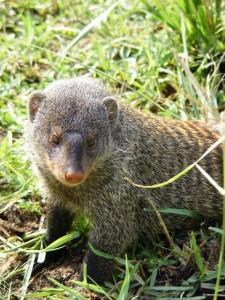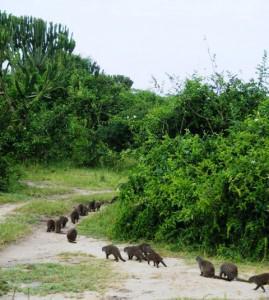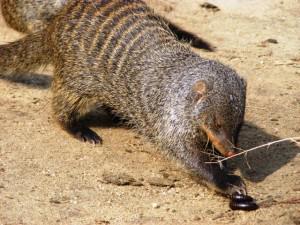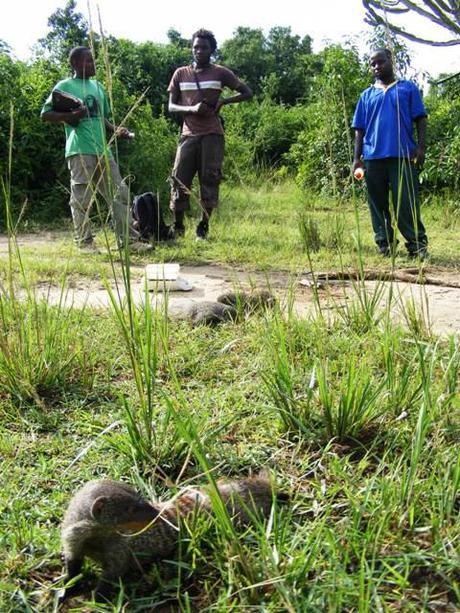I often forget when we go out into the Bush how, even on short distances, a vehicle is necessary. And so, armed not with a gun or a machete, but a long radio antenna, we jumped into the back of a pickup truck and headed off the main track and into the scrubby bush.
The sun was shining as we watched Pink-backed Pelicans sailing down the Kazinga Channel towards us. Within just a few minutes, our researcher guides Solomon and Francis had tracked down our family, one of six habituated groups of Mongooses* living on the Mweya peninsula. Fifteen years of research have given Solomon, Kenneth and Francis an intimate knowledge of the nine families of Mongooses.

Cute and fluffy or too much like a rat to you? Endlessly fascinating Mongooses
Our job for the morning was to weigh each of the 32-member family. But where do you start?
With a call of “coo-coo-coo-coo-coo” the mongooses come trotting out of the Bush, snorting, sniffing, whistling and chirruping.
Well, would you believe it – these guys can be identified by their different haircuts! Every two weeks each mongoose has a number clipped into the fur onto its back to identify it, invaluable in monitoring their health.

Our family of Mongooses trot off into the Bush at Mweya, Queen Elizabeth National Park, Uganda
As the family rolled up, we set to work. Each Mongoose was individually weighed and its personal number and weight noted down. (What impressed me was how Solomon managed to remember which ones he’d weighed). Later, the data is compared to check that pups are growing healthily and to monitor pregnancies amongst the family.
During the weighing, Solomon and Kenneth told us more about mongoose society.
Known as ‘cooperative breeders’ the females will all give birth on the same day. Incredible! As many as 15 pups will be born and can be suckled by any of the females. Pups will then choose which male – the babysitters of the species – will care for them. According to Solomon, a pup can distinguish between a good or a bad parent. (These fascinating creatures could surely be good role models to a few men we could mention!)
If a subordinate female becomes pregnant, when the dominant four females aren’t, she will be “beaten up” in Solomon’s words, and forced to abort. If she’s lucky, she will then be allowed back into the group (the risk being that if subordinates keep getting pregnant they threaten the dominance of the group). Examples of this behaviour was captured on the BBC TV series Banded Mongooses, aired in 2010.
We asked endless questions during our morning with the Mongooses and the guys were a mine of information. They pointed to last night’s sleeping place and told us how Mongooses change their den every two or three days. After a few days, they may return to the same den (once the fleas have died down!)
When I commented on how healthy they looked, Solomon replied “Yes, these are rich guys. They live near the Lodge!” Rubbish from the Lodge and the hostel is collected and taken to a covered pit, but with so many tourists passing through Mweya, it’s inevitable there are still scraps of food to be scavenged.

Beetles, insects, small snakes, rodents, lizards and eggs are all part of a mongoose’s diet
When they find a rat, “they go crazy and make a lot of noise,” Solomon said, to attract the rest of the group to the hunt. We watched as a Mongoose (carefully) attacked a giant Millipede, bashing it against the ground to first remove its poison. The others were quick to dive in and help him eat it.
When they’re not busy foraging or fighting, mongooses can be seen removing the ticks and lice from compliant warthogs. Did you know this behaviour only happens in Queen Elizabeth? Other unusual behaviour witnessed here was the sight of a Mongoose taking a dip in the lodge pool! (I hear the Lodge waives the entrance fee for Mweya residents).
To get closer to the action, I sat on a tuft of grass at the edge of the track while I watched. Note: sitting down on the bare grass is not recommended. By afternoon, my legs were itching like crazy!
As we were talking, we heard a car pass along the track above us. Every Mongoose was on high alert, heads turned in the direction of the noise, on their back legs, scanning the horizon. With a piercing shriek, the crew scattered. As one, they headed for cover.
“If they see a Leopard they will just freak and run” said Solomon. “Even if they find the dung of a lion, they run!” (So so might I!)
The Mongooses’ greatest enemies are the Leopard and the Python. Just recently a Leopard had attacked their den and eaten five of them. At Kabatoro Gate, a Python had eaten a mongoose wearing the radio collar. They’d tracked the perpetrator of course! (I wonder how long it was before the researchers realised exactly what they were tracking?)

How to book
A few hours – or longer – in the presence of these very knowledgeable researchers, who so obviously love their subjects, is a great way to get up close to nature, support conservation and see the park from a different angle. Unlike some other wildlife experiences, you can get out of the car and even let the Mongooses run between your feet.
The experience can be booked with the Uganda Wildlife Authority by calling Agnes on +256 772638531 or by emailing aggie dot nakidde at gmail dot com
Why mongooses?
There are 32 species of Mongooses in the world, of which only four are social: the Meercats, the Dwarf, the Yellow and the Banded Mongooses.

